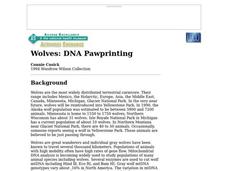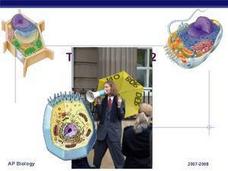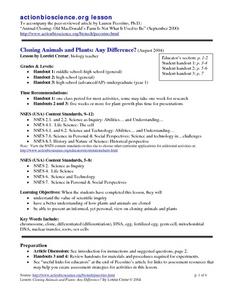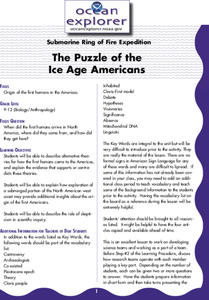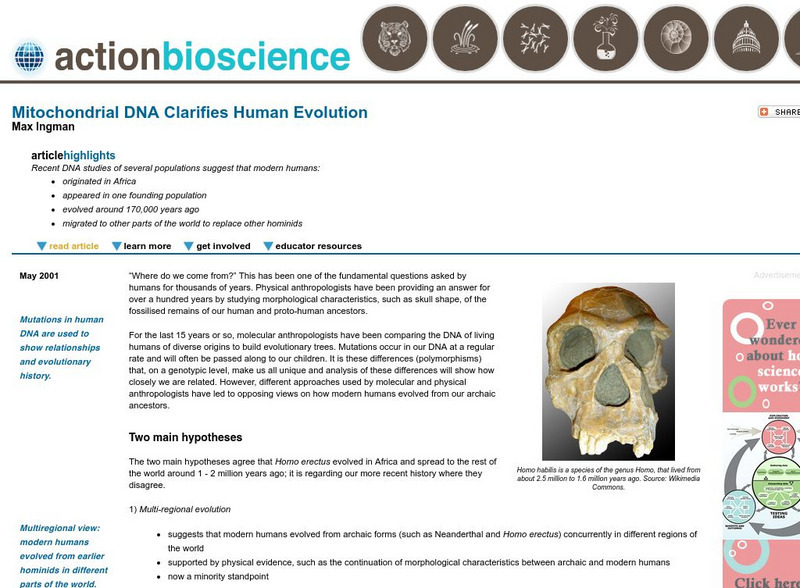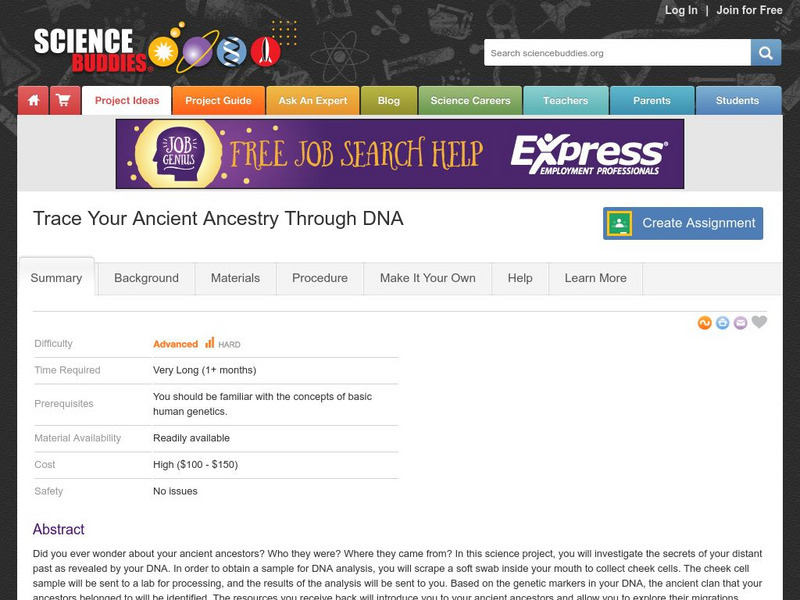Howard Hughes Medical Institute
Using DNA to Explore Lizard Phylogeny
In a fun and interactive two-day lesson, learners sort anole lizard pictures by appearance. Next, they watch a video about the anoles and re-sort based on the information in the video. In addition to physical characteristics, budding...
Curated OER
Wolves: DNA Pawprinting
A mystery canine was shot and killed near Yellowstone National Park in the early '90s. Genetics whizzes explain how they might go about identifying whether the animal was a true grey wolf or a hybrid. A drawing of the animal's DNA bands...
Curated OER
Wolves: DNA Pawprinting
Students explore and research the most widely distributed terrestrial carnivore, the wolf. They critique the true mystery of this animal and then form an opinion about this creature. The restriction-site analysis of mitochondrial DNA is...
Curated OER
Roots: The Ancestry of Modern People
High schoolers investigate the models for the origin of modern humans and the conditions that facilitate speciation and evolution. The classification and nomenclature of hominid species is also examined.
Curated OER
America's Stone Age Explorers
Students research how mitochondrial DNA is used in determining familial relationships. They complete a worksheet in which they attempt to help solve the identity of bones found in Africa.
Curated OER
Human Origins: The Prehistoric Human Race
When it comes to the origin of the human species students are full of misconceptions. Clear up the hominid confusion with this evolutionary activity focused on assisting students in understanding prehistoric man and his family tree....
Curated OER
Global Awareness
Students read about how scientists are arriving at current theories of human origin and migration through mitochondrial DNA analysis. They then piece together a map showing the data from mitochondrial DNA analysis to plot the migration...
Curated OER
Determination of Phylogenetic Relationships Using Restriction Analysis
Students applied various mathematical analyses to interpret their data. By using the resulting DNA fragment patterns from several enzymes students established a possible evolutionary relationship among the mice.
Curated OER
Recovering the Romanovs
Students use DNA to solve an identity mystery. In this biology lesson plan, students use the Internet to gather information about sex-linked disorders and complete a Punnett square for hemophilia, then examine a handwriting analysis,...
Curated OER
Making Twins
A short reading is accompanied by a quiz in a resource describing the differences between identical and fraternal twins. The quiz is mostly true/false and would make an excellent anticipatory set to get kids thinking about what they know...
Curated OER
The Real Eve
Students research about human migration during a specific time period. In this physical science lesson, students watch a video about human evolution. They prepare a presentation on human migration and share it with the class.
Curated OER
Comparing Chimp mtDNA to Learn about Races
In this computer-based lesson, students will measure genetic diversity within and between three subspecies of chimpanzees in order to gain a better understanding of genetic distinctiveness and explore race as a genetic concept.
Curated OER
America's Stone Age Explorers
Students watch a Nova program examining the earliest in habitants of the Americas. In groups. they take notes on various topics covered in the program. Among the topics covered are: the Clovis people, Solutrean culture, migration...
Field Museum
The Case of Darwin's Finches
One of the most striking pieces of evidence for Darwin's Evolution of Species was his observations of finches and how their beaks differed from island to island, depending on their primary food sources. So what would happen to the theory...
Curated OER
Cellular Respiration Oxidation of Pyruvate Krebs Cycle
Diagrams with annotations are shown on each of these eighteen slides, which summarize the processes of respiration. The focus is on the 3-step oxidation process and the Krebs cycle. Students should be able to follow these slides...
Curated OER
Tour of the Cell 2
As your class views each slide, they will be introduced to the organelles and structure of the cell. Details about structure and function are given and also some trivia about their frequency and population. There is also some...
Cold Spring Harbor Laboratory
Higher Cells Incorporate an Ancient Chromosome
Chromosomes contain keys to history including links from royalty to Neanderthals. Young scientists learn about Ivan Wallin's research into chromosomes with an animation and videos. Then, the concept connects to mysteries related to...
Curated OER
Cloning Animals and Plants: Any Difference?
Students examine the process in which plants and animals are cloned. They compare and contrast the two procedures and determine if there is a difference. They share their views on cloning to the class.
Curated OER
The Puzzle of the Ice Age Americans
Students describe alternative theories for how the first humans came to the Americas, and explain evidence that supports or contradicts these theories. They examine the role of skepticism in scientific inquiries.
National Institutes of Health
National Library of Medicine: Genetics Home Reference: Mitochondrial Dna
A thorough overview of mitochondrial DNA.
American Institute of Biological Sciences
Action Bioscience: Mitochondrial Dna Clarifies Human Evolution
Deep mitochrondrial DNA research has revealed information identifying the origin of modern humans, the founding population, a general date of humans evolving, and the migration of these humans across the planet. Read further to discover...
American Institute of Biological Sciences
Action Bioscience: Mitochondrial Dna Clarifies Human Evolution (2001)
DNA of the mitochondria has most commonly been used to construct evolutionary trees. New field of population genetics hopes to resolve important questions in migration theories that involve Aboriginies in Australia, North America, and...
Science Buddies
Science Buddies: Trace Your Ancient Ancestry Through Dna
In this science project, you will investigate the secrets of your distant past as revealed by your DNA. In order to obtain a sample for DNA analysis, you will scrape a soft swab inside your mouth to collect cheek cells. Based on the...
PBS
Nova: Identifying Remains With Dna
Mitochondrial DNA has different properties than nuclear DNA which make it beneficial in certain forensic settings. Get the details on the ways mitochondrial DNA is being used in forensic science.



